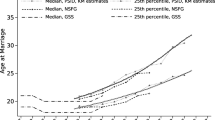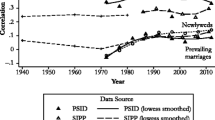Abstract
The extent of marital sorting by socioeconomic background has implications for the intergenerational transmission of inequality, the role of marriage as a mechanism for social mobility, and the extent of cross-group interactions within a society. However, studies of assortative mating have disproportionately focused on spouses’ education, rather than their social origins. Using data from the Panel Study of Income Dynamics (PSID), and exploiting the unique genealogical design of the data set, we study the degree to which spouses sort on the basis of parental wealth. We find that the estimated correlation in parental wealth among married spouses, after controlling for race and age, is about .4. Importantly, we show that controlling for spousal education explains only one-quarter of sorting based on parental wealth. We show that our results are robust to accounting for measurement error in spousal reports of parental wealth and for selection into and out of marriage.
Similar content being viewed by others
Notes
The PSID elicits responses via “unfolding brackets” for those who did not provide an exact response. Respondents were asked whether their parents’ wealth was greater than or less than $25,000. If they responded greater than $25,000, they were subsequently asked whether it was greater than or less than $100,000. If they initially responded that it was less than $25,000, they were subsequently asked whether it was greater than or less than $1,000.
An exception occurs when one divorced parent is reported to have negative wealth and one positive. Because total wealth is unknown, it is not possible to meaningfully combine reports in this case.
Some assortative mating on the basis of parental wealth may reflect assortative mating on the basis of race, coupled with racial differences in parental wealth (see Oliver and Shapiro 1995; Conley 1999 and Barsky et al. 2002). We perform the analysis in Table 2 separately by race and find strong parental wealth sorting patterns within racial groups (whites and nonwhites).
There are too few interracial couples in the sample to control separately for each spouse’s race. We use the race of the husband, when it is available. Otherwise, we use the race of the wife.
More than 96 % of PSID parents reported positive wealth.
Allowing for full interactions of husbands’ and wives’ education levels does not diminish our TSLS estimates of parental wealth sorting, relative to the estimated coefficients in Panels B and C of Table 6.
All the detailed results, including the specific sample descriptions, can be found in the Online Resource 1.
References
Barsky, R., Bound, J., Charles, K. K., & Lupton, J. P. (2002). Accounting for the black-white wealth gap: A nonparametric approach. Journal of the American Statistical Association, 97, 663–673.
Becker, G. S. (1973). A theory of marriage: Part I. Journal of Political Economy, 81, 813–846.
Blau, P. M., & Duncan, O. D. (1967). The American occupational structure. New York: Wiley.
Burgess, E. W., & Wallin, P. (1943). Homogamy in social characteristics. The American Journal of Sociology, 49, 109–124.
Centers, R. (1949). Marital selection and occupational strata. The American Journal of Sociology, 54, 530–535.
Charles, K. K., & Hurst, E. (2003). The correlation of wealth across generations. Journal of Political Economy, 111, 1155–1182.
Conley, D. (1999). Being black, living in the red: Race, wealth, and social policy in America. Berkeley: University of California Press.
Epstein, E., & Guttman, R. (1984). Mate selection in man: Evidence, theory, and outcome. Biodemography and Social Biology, 31, 243–278.
Fernández, R., & Rogerson, R. (2001). Sorting and long-run inequality. Quarterly Journal of Economics, 116, 1305–1341.
Hout, M. (1982). The associations between husbands’ and wives’ occupation in two-earner families. The American Journal of Sociology, 88, 397–409.
Kalmijn, M. (1991). Status homogamy in the United States. The American Journal of Sociology, 97, 496–523.
Kremer, M. (1997). How much does sorting increase inequality. Quarterly Journal of Economics, 112, 115–139.
Lam, D. (1988). Marriage markets and assortative mating with household public goods: Theoretical results and empirical implications. Journal of Human Resources, 23, 462–487.
Mare, R. D. (1991). Five decades of educational assortative mating. American Sociological Review, 56, 15–32.
Mulligan, C. B. (1997). Parental priorities and economic inequality. Chicago, IL: University of Chicago Press.
Oliver, M. L., & Shapiro, T. M. (1995). Black wealth/white wealth: A new perspective on racial inequality. New York: Routledge.
Pagnini, D. L., & Morgan, S. P. (1990). Intermarriage and social distance among U.S. immigrants at the turn of the century. The American Journal of Sociology, 96, 405–432.
Panel Study of Income Dynamics, 1968–2007 Family, 1968–2007 Cross-Year Individual, public use data sets. (2010). Produced and distributed by the University of Michigan with primary funding from the National Science Foundation, the National Institute of Aging, and the National Institute of Child Health and Human Development. Ann Arbor, MI.
Pencavel, J. (1998). Assortative mating by schooling and the work behavior of wives and husbands. American Economic Review, 88, 326–329.
Rubin, Z. (1968). Do American women marry up? American Sociological Review, 33, 750–760.
Schwartz, C. R., & Mare, R. D. (2005). Trends in educational assortative marriage from 1940 to 2003. Demography, 42, 621–646.
Solon, G. (1992). Intergenerational income mobility in the United States. American Economic Review, 82, 393–408.
Solon, G. (1999). Intergenerational mobility in the labor market. In O. Ashenfelter & D. Card (Eds.), Handbook of labor economics (Vol. 3, pp. 1761–1800). Amsterdam, the Netherlands: Elsevier.
Uunk, W. J. G., Ganzeboom, H. B. G., & Róbert, P. (1996). Bivariate and multivariate scaled association models. An application to homogamy of social origin and education in Hungary between 1930 and 1979. Quality and Quantity, 30, 323–343.
Zimmerman, D. J. (1992). Regression toward mediocrity in economic stature. American Economic Review, 82, 409–429.
Acknowledgments
We thank Daron Acemoglu, Mark Aguiar, Steve Levitt, Bruce Meyer, and Emily Oster, along with seminar participants at the University of Chicago for helpful comments. Charles gratefully acknowledges support from the Searle Freedom Trust. Hurst acknowledges financial support from the University of Chicago’s Graduate School of Business. Killewald acknowledges financial support from the Gerald R. Ford School of Public Policy, Rackham Graduate School, and the Quantitative Methodology Program in the Survey Research Center, all at the University of Michigan. The Panel Study of Income Dynamics is primarily sponsored by the National Science Foundation, the National Institute of Aging, and the National Institute of Child Health and Human Development, and is conducted by the University of Michigan. All authors have contributed equally to the project, and we use the convention of alphabetical listing of author names.
Author information
Authors and Affiliations
Corresponding author
Electronic Supplementary Materials
Below is the link to the electronic supplementary material.
ESM 1
(PDF 240 kb)
Rights and permissions
About this article
Cite this article
Charles, K.K., Hurst, E. & Killewald, A. Marital Sorting and Parental Wealth. Demography 50, 51–70 (2013). https://doi.org/10.1007/s13524-012-0144-6
Published:
Issue Date:
DOI: https://doi.org/10.1007/s13524-012-0144-6




